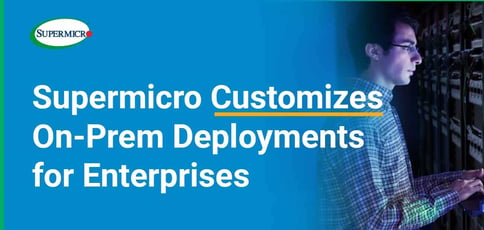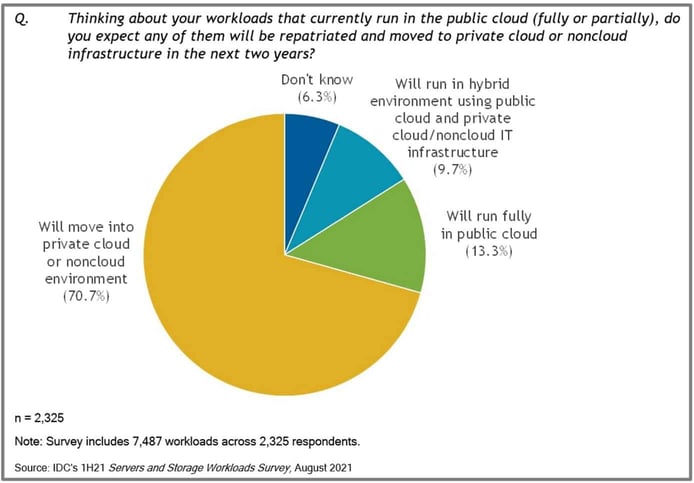
TL; DR: Supermicro delivers optimized server infrastructure customized to business needs. The company helps enterprises that are migrating partially from the public cloud balance and create hybrid cloud environments. With its on-premises services, businesses can reduce cloud costs, gain control of their features, and find peace of mind in architecture predictability for their core workloads.
Global cloud shifts have marked the last decade, even more so during the COVID-19 pandemic. Many companies underwent a digital transformation, transferring their data and workloads to cloud networks at a rapid rate. The cloud market also continues to grow, boasting a CAGR percentage of 15.8% between 2022 to 2028, as more people adopt its benefits and leverage its power for their operations.
But the cloud’s value and popularity can’t ignore its disadvantages in the long term. Although the cloud offers top-notch performance and scalability, many enterprises are finding that it is putting pressure on their marginal profits and long-term success. According to IDC, 71% of companies reported that they would repatriate and move some of their cloud workloads into a private cloud or non-cloud environment.

“It sounds great when you move everything from CapEx to OpEx. But it turns out when you buy something, you have it,” said Michael McNerney, VP of Marketing and Network Security at Supermicro. “When you pay OpEx, that price changes. It can change as you consume more and spend a lot more trying to do these things. With data egress and data ingress, there’s a lot of surprise charges people are seeing.”
Supermicro helps businesses position themselves to reap the benefits of a modernized hybrid cloud environment by building customizable and optimized on-prem solutions. On-premises IT infrastructure allows companies to gain control, reduce costs, and manage predictable hardware with fewer disruptions or surprises. By combining cloud and on-premises servers, enterprises can experience the best of both worlds.
Finding the Right Balance of Cloud and On-Premises Servers
Investing in on-premises servers doesn’t mean companies should completely abandon their external, outsourced cloud services. Michael explained that it’s all about striking the right balance of public cloud and on-prem infrastructure. Companies should look at the workloads where they need to improve control, cost, and predictability to store on private servers.
“That idea of where on the spectrum of do I run it on-prem? We think the right answer for most customers is their core workloads. The workloads that will differentiate your value are really where you want to look into these things,” Michael said.
Twitter and Intel are two organizations that leverage hybrid cloud environments for their operations. By doing so, they optimize cost output and build infrastructure that can handle their growth without raising expenses. Their core workloads can take the front seat.

“So if it’s Intel, I’m designing chips. If it’s Twitter, I’m running my social media service. And those are the parts of the cloud you want to own, run, optimize, and deliver best-in-class services. My HR systems, CRM systems, and those applications, that move out to the public cloud or maybe to software as a service,” said Michael.
Twitter still uses the public cloud for cold storage but relies on custom-built servers for its main platform objectives. Since its application often sees spikes in online traffic, it needed a tailored cloud solution that could handle those spikes without interruptions. Its on-prem solution answered this need and was less expensive and more effective than the public cloud’s general-purpose hardware.
Intel’s on-premises servers allow the company to focus on innovation and keep it in-house. The company also had specific needs and requests that public cloud providers couldn’t meet. So it turned to on-premises infrastructure to optimize specifically for the architecture of its operations. Intel was able to get better performance and more control at a lower cost by building its own datacenters.
Customizing Optimized Infrastructure for On-Prem Deployment
High-value workloads are intricately connected to a company’s success. These workloads are what businesses are known for and take precedence over other priorities. That is why companies need a tailored architecture that meets the performance needs of their workloads. With on-premises infrastructure, companies can define their specifications.
“So the thing we’re seeing at Supermicro is as customers come back from the public cloud, they want to optimize that cloud by definition,” said Michael.
Supermicro helps businesses develop infrastructure customized to their needs. Companies no longer want traditional legacy systems or run-of-the-mill hardware; they want enhanced cloud solutions. Thankfully, the Supermicro team manufactures and designs optimized servers in-house for its customers.
“We’ve seen, especially with some of the supply chain issues, this demand for more rack level solutions versus individual servers. So build the entire rack, the networking, the storage, power and cooling, and put this whole thing in place for me,” Michael said.
Recent supply chain issues have prompted Supermicro customers to opt for integrated rack solutions instead of ordering individual storage boxes or servers to put together themselves. This way, they won’t have to wait for other parts to build or to get their operations going. Supermicro’s experience has also helped it navigate supply chain hardships.
“Since we have in-house design and manufacturing, our ability to control that supply, as a single-throat-to-choke, actually gave us a competitive advantage because we could see the whole thing and look in the warehouse for parts. We’re going 29 years at this, so we’ve been through a few ups and downs,” said Michael.
Heeding the Renaissance of the Hardware Industry
Michael told us about the growing abundance of choice in the hardware industry and how it will impact consumer decisions.
“If you look at the hardware side of the business, it’s a good time for the customer. There is a ton of innovation coming out from Intel, AMD, Nvidia, Broadcom, and all the storage vendors. If you look at every single front, there are fundamental changes,” said Michael.
Technology is advancing, and customers no longer have to choose one-size-fits-all models. Manufacturers are offering accelerated GPUS, refreshing CPUs with new innovative capabilities, and releasing new storage architecture and drive designs, among other features. But all these new options pose a tough challenge for customers to choose which parts are the best fit for their businesses.
“There’s a lot of value there, and it’s added complexity because of all the choices that are coming and added risk. Because if you ignore those choices and your competitor doesn’t, that’s not going to be good,” said Michael.
Michael also said there was almost a singular focus on software, but hardware has now joined these talks. Companies need to pay closer attention to the hardware choices running their software because the hardware industry is evolving quickly with new, powerful technologies. Good thing, Supermicro will be there to help customers pick up the pieces along their hardware transformation journey.
“As these companies are moving applications back, we feel that optimized infrastructure will be the exciting opportunity. They’re not looking to move it back to a traditional legacy architecture. And that’s where we’re seeing the business go,” said Michael.


